In daily office work, work information flows across different scenarios such as group chats, email, documents, and more on DingTalk. Enterprises hope employees can promptly obtain and understand key information such as project progress and task assignments. Therefore, information efficiency has become an important indicator of collaborative work: the higher the information efficiency, the lower the communication cost and the fewer misunderstandings or conflicts, ultimately accelerating the overall development of the enterprise. In the intelligent era, how will office efficiency be reshaped when AI dives into various collaboration aspects like team communication, task management, and knowledge sharing? In July 2023, Miaoyaa Camera went viral on major social platforms, gaining a high-quality personal photo album for just ¥9.9 and 20 photos. Although Miaoyaa Camera's generation capabilities are not as rich or refined as Midjourney, it successfully leveraged AI to simplify processes like makeup styling and photo selection/editing in the photo-taking scenario, rapidly spreading via user self-propagation and becoming the first AI application to breakout across its domain. Miaoyaa Camera's success undeniably verifies a clear direction for the practical implementation of AI applications: if the first half of AI was driven by computing power upgrades, then the second half should be driven by scenario-based innovation. "Essence of Interaction Design 4.0" once proposed a concept known as "Goal-Oriented Design," breaking down scenarios into three elements: who the actors are, what tasks they perform, and what goals are achieved. Collaborative work environments happen to feature the characteristics of multiple actors and goals; employees in different positions participate in the circulation of information with diverse aims. Therefore, collaborative work environments offer ample opportunities for innovation in "scenario + AI" exploration.
In daily office tasks, work information flows across various scenarios such as group chats, emails, and documents on DingTalk. Enterprises hope their employees can immediately acquire and understand key information such as project progress and task allocation. Therefore, information efficiency has become a critical indicator of efficient collaborative work: the higher the information efficiency, the lower the communication costs and fewer misunderstandings or conflicts arise, ultimately enhancing the developing speed of the entire company.
In the intelligent era, how will office efficiency be reshaped when AI deeply integrates into various collaborative aspects like team communication, task management, and knowledge sharing?
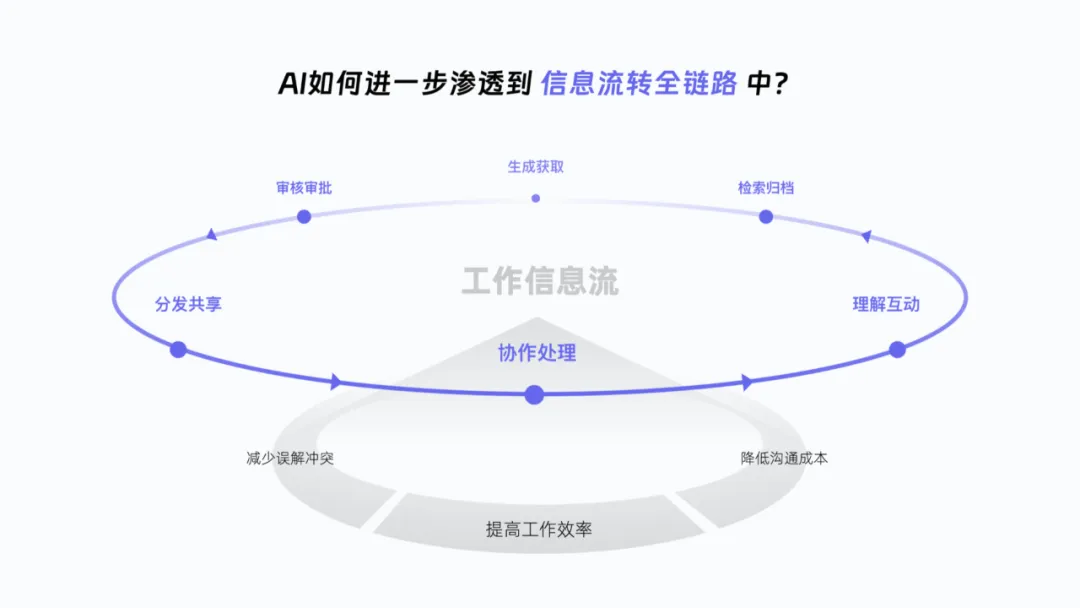
Scenario + AI Exploratory Practice
$"The first half of AI was driven by computing power upgrades, the second half by scenario-driven innovation"$
In July 2023, Miaoyaa Camera went viral on social media, with users able to purchase high-quality customized personal photos for just 9.9 yuan and twenty images. Although the richness and refinement of Miaoyaa Camera's image generation are not on par with Midjourney, its use of AI in the personal portrait scenario simplified steps like makeup styling and photo editing and selection. Additionally, the app quickly virally spread through self-dissemination by users, making it the first AI application to "break the circle" or go mainstream.
Miaoyaa Camera's success undoubtedly provides a clear validation path for AI application development: if the first half of AI was driven by computing power upgrades, the second half should be driven by scenario-based innovation.
"Essence of Interaction Design 4.0" has proposed a concept called "Goal-Oriented Design", which breaks down scenarios into three components: which role, through which task, achieves which goal. Collaborative work environments precisely possess the characteristics of multiple roles and multiple goals, with employees from different job positions participating in information circulation with differing objectives. Hence, the collaborative work environment offers rich opportunities for innovative exploration of "Scenario + AI".
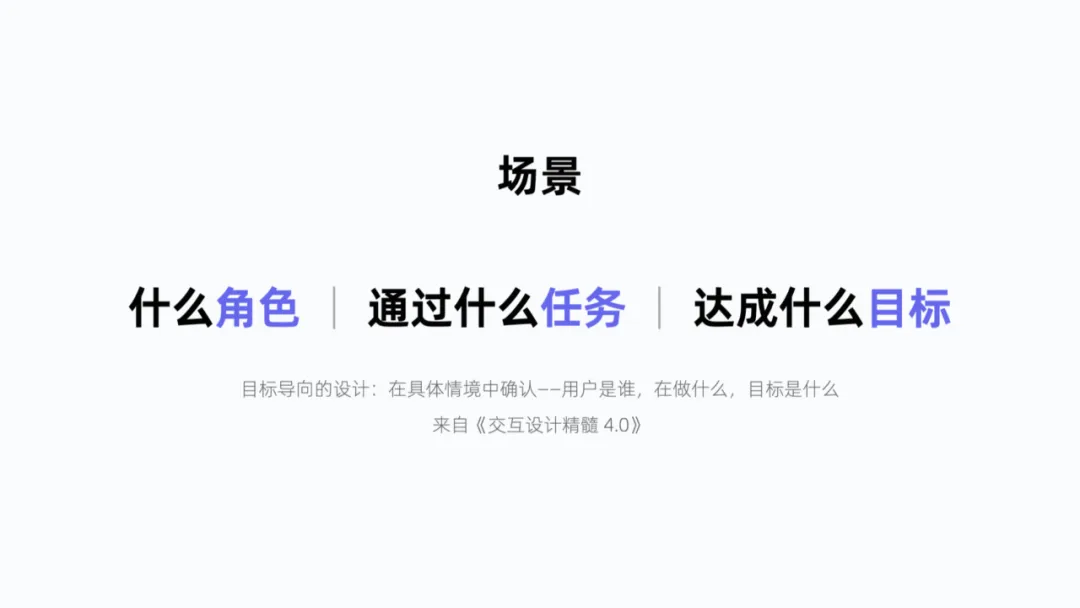
Next, through three different innovative design case studies, I will share with you how we integrate AI into different stages of information flow.
01. Event Smart Poster
$"Promotion Scenario + AI, Making Information Sharing More Exquisite"$
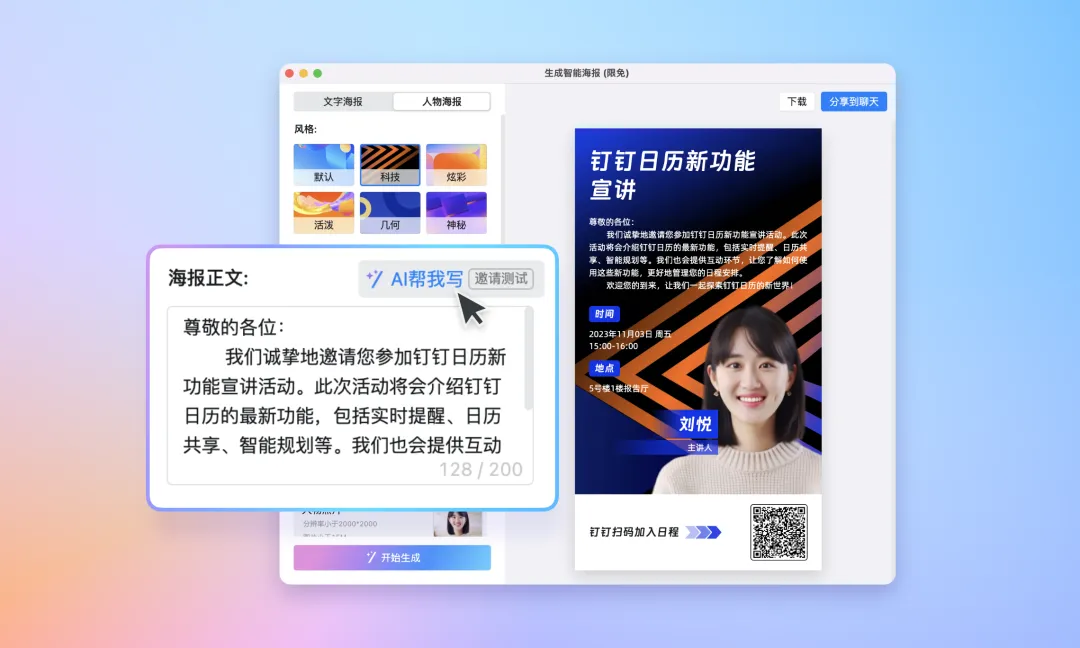
Insightful Scenario
When hosting various events on campus, organizers would usually create an event poster and stick on the host's photo to attract the audience to join the event.
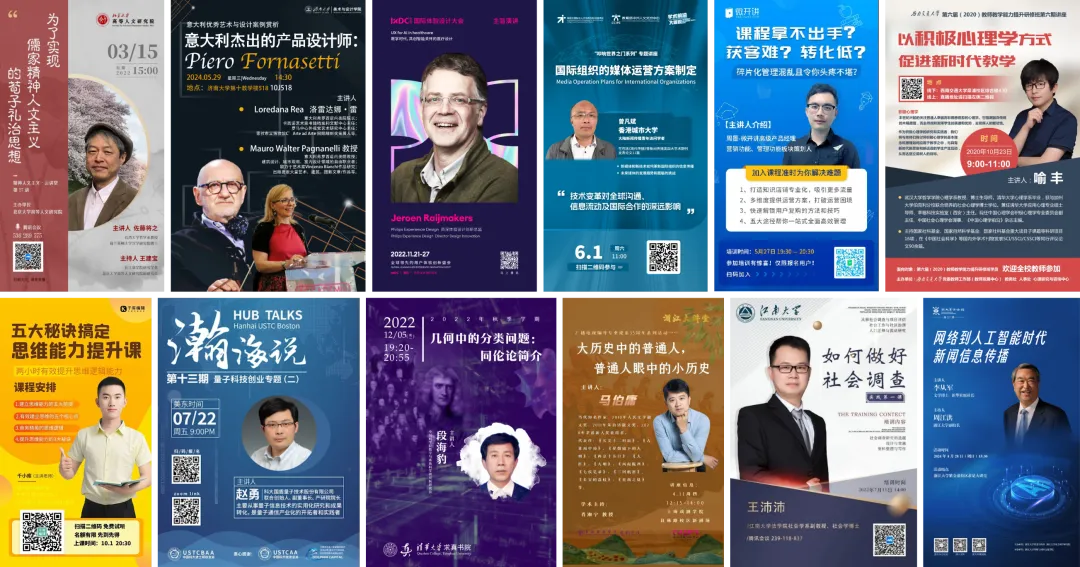
Tongyi Qwen has the ability to generate primary product images smartly. It can automatically cut out product images and quickly combine them with product descriptions to create a product promotion image. Simply pairing brief product descriptions and images with nice background designs can attract users to purchase.
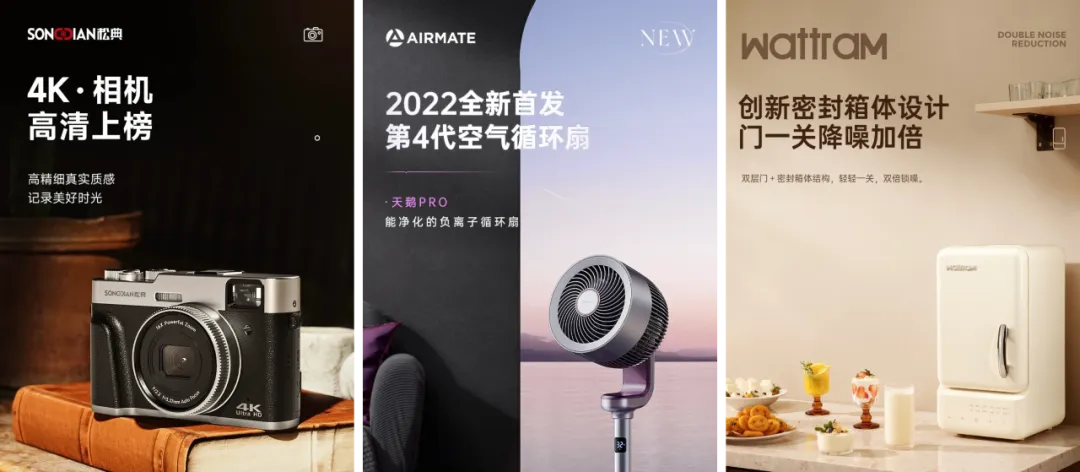
When we consider the two images mentioned above together, we see they have a very similar structure, as both are related to marketing scenarios.
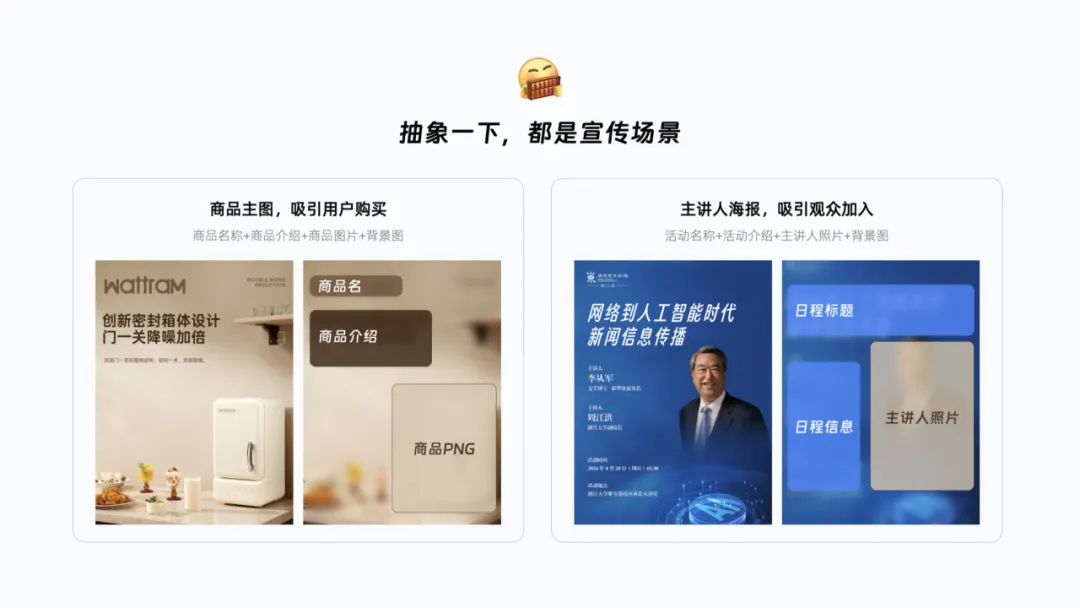
Scenario Analysis
In the previous sections, we highlighted from the book, the three elements of a scenario as "role, action, and objective." Now, let's analyze the scenario of making an event poster to promote a training course from these three elements: The roles involved are the administrative and poster designers from the preparation team, who need to accomplish at least seven tasks from information collection to promotion distribution. The ultimate goal of creating the poster is to attract other colleagues to join the event.
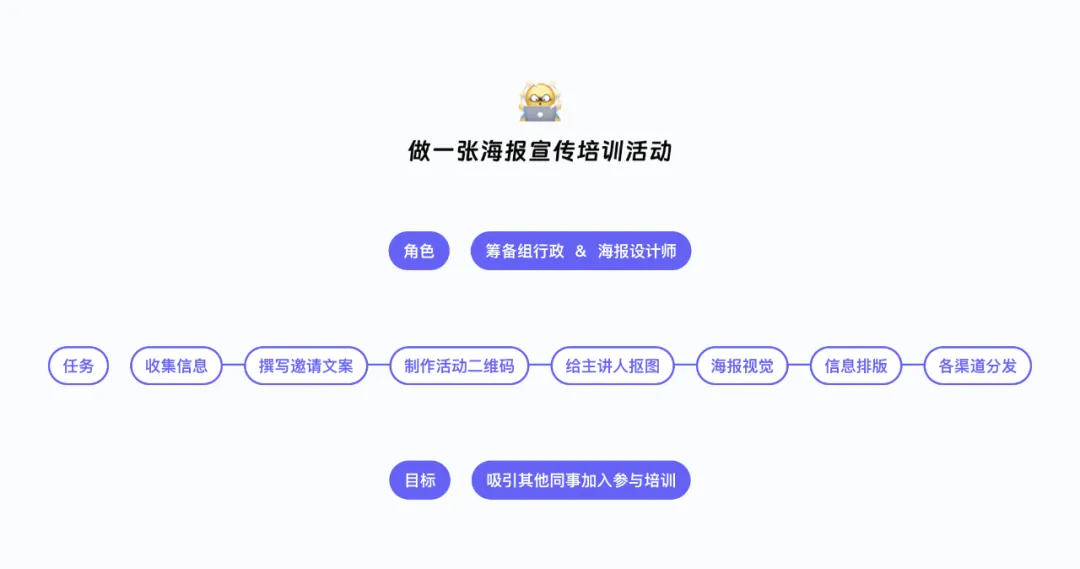
Looking at these task steps, such as writing copy, generating QR codes, image clipping, and visual layout, it seems each could be completed by combining existing technologies with AI capabilities. So why don't we use AI to handle these repetitive, monotonous tasks, allowing event organizers to achieve their goals more quickly?
Solution Design
We breakdown the poster structure: the "event information" can leverage AI's creative capabilities to help draft promotional copy; the "background image" can be generated by AI; with mature technology, the "speaker photo" can be quickly clipped; and additionally, the "event link" can be automatically converted into a QR code for attendees to scan and sign up.
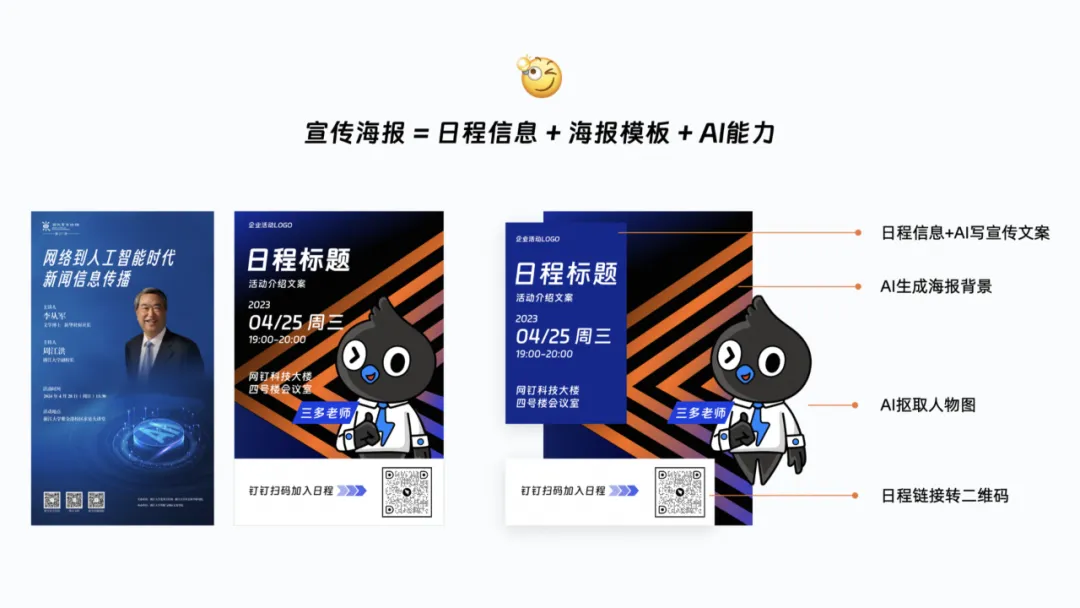
Once these repetitive and mundane tasks are handled, our intelligent poster solution is essentially shaped. Next, how do we bring this idea to fruition into a valuable user function?
Find the user's first intuitive path:
Firstly, find a suitable entry point for the idea. When people want to invite others to an event, the first step is often sharing the event schedule.
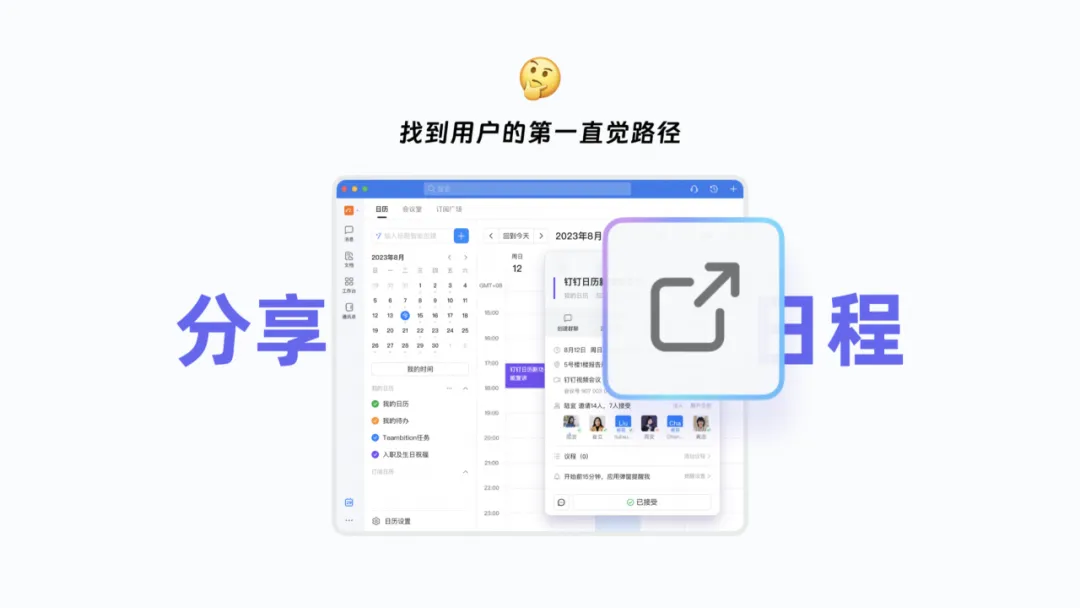
Find the best way for information flow:
Within DingTalk, group chats are undeniably the optimal medium for the broad dissemination of information. Posters distributed as card messages in group chats allow colleagues of interest to directly join events via the action points on the card.
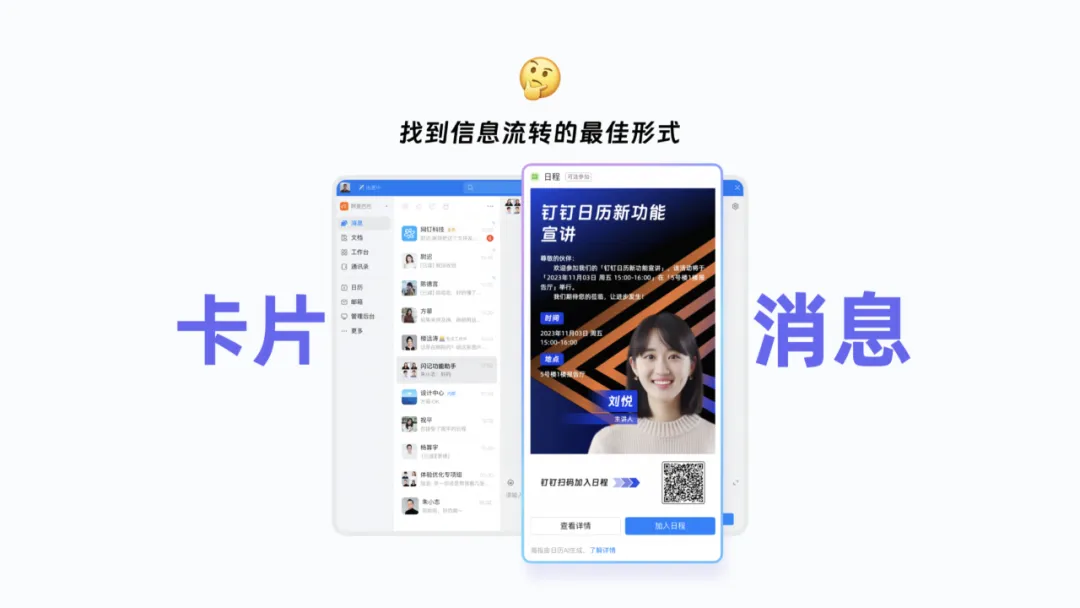
Let more people feel the value of the feature:
Add a small tail to the card that guides interested users to learn more about the details, highlights the feature’s strengths, so that maybe the next time someone needs to create a poster, they'll remember this function.
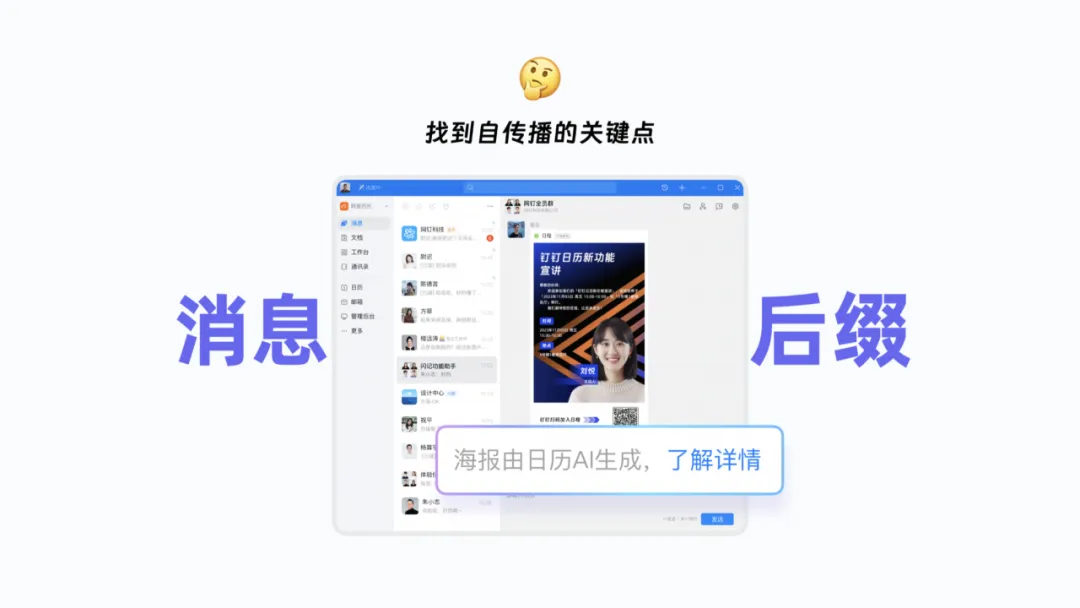
Innovative Implementation
Thus, our smart poster solution was successfully launched, allowing users to generate and share schedule event posters directly in group chats from a single click within DingTalk, supporting both text posters and people posters.
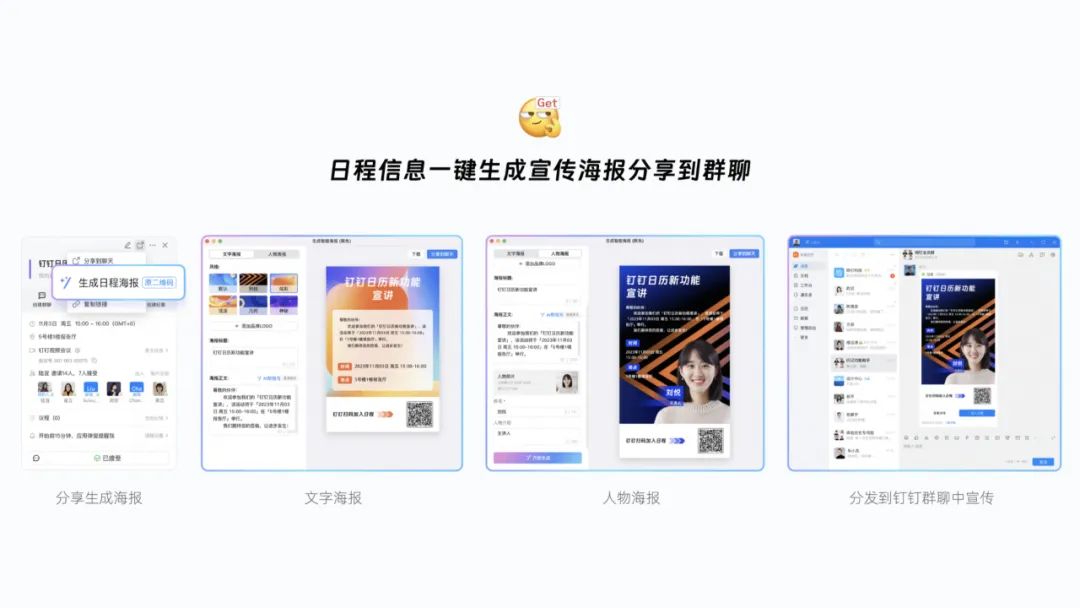
The feature has received a lot of positive feedback from major clients after its launch, reducing the costs related to event promotion for corporate training, knowledge lectures, and other meetings, and liberating event promoters from tedious and repetitive work tasks.
02. Natural Language for Creating Events
$"Team Meeting Scenario + AI, Making Information Distribution More Convenient"$
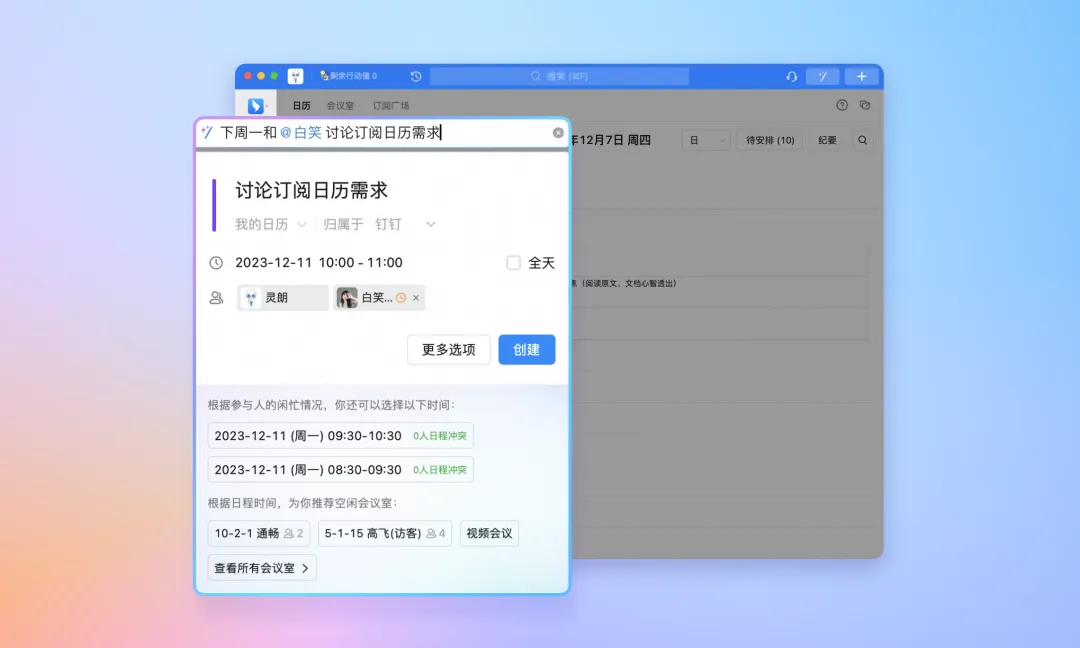
Identifying the Problem
In daily work, if you want to discuss with your colleagues, you would usually create an event in the DingTalk calendar in advance and send out meeting invitations to reserve their time. However, our event creation form has received a lot of complaints from users: scheduling events is too complicated.
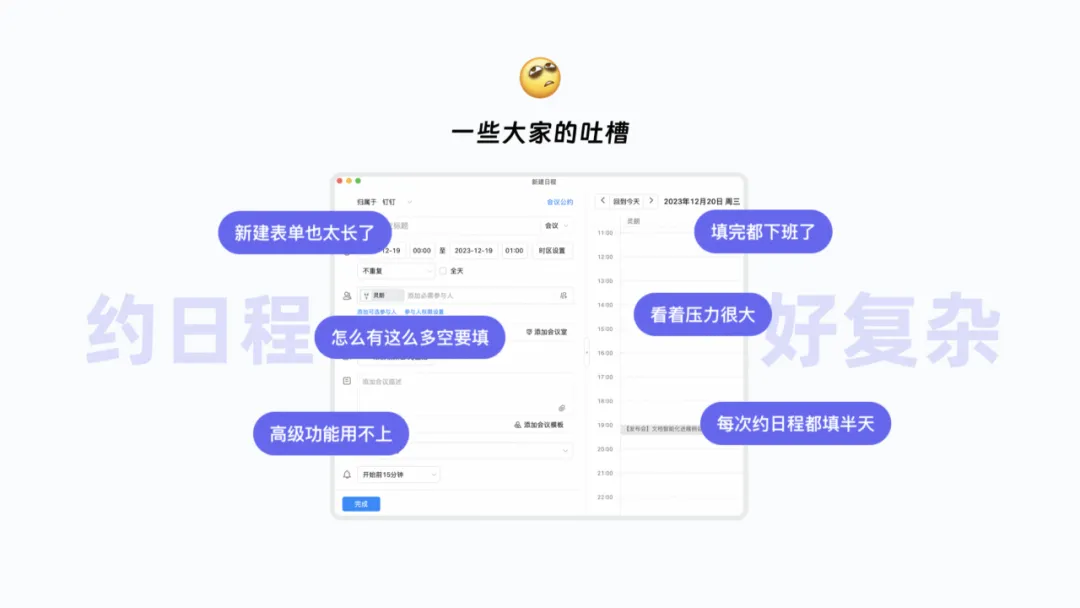
The current new event form contains a total of thirteen input fields, which can make the user feel pressure when filling them out.
Traditionally, our optimization approach would be to adjust the form's order, categorize and group fields, and try to simplify the interface by tweaking its information architecture. However, with AI now at our disposal, can we find alternative optimization approaches?
Scenario Analysis
Taking the booking of a design review meeting as an example, we will break down the scenario from the three dimensions: role, task, and goal. The role is the meeting-organizing designer; determining the meeting topic first, coordinating with colleagues' availability and the meeting room's schedule to find a convenient time, then filling out that lengthy event creation form, and finally sending out the meeting invitation. The goal is to find a proper time and place to inform everyone and discuss the design.
What can we uncover from these tasks? Looking at the data, we find that filling just four fields—title, time, participants, and meeting room—is sufficient for creating 84% of new events. Through user interviews, we found that people reported the most trouble as determining the time based on participants' availability and meeting room scheduling.
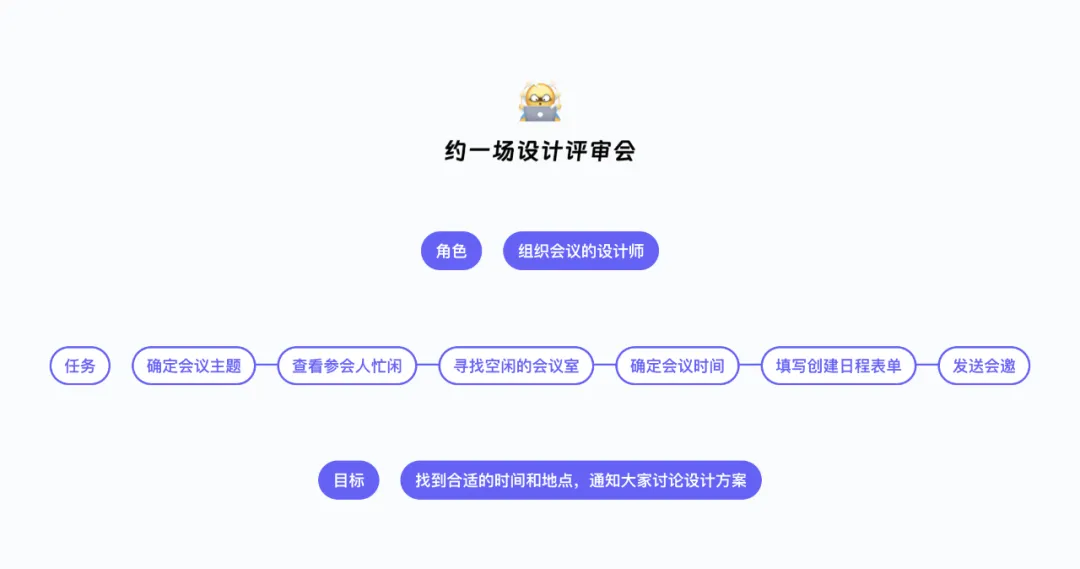
Not to limit ourselves by the original task processes, we explore simpler forms under AI's empowerment, enabling meeting organizers to directly find and inform the convenient time and location for discussion. If they find thirteen input fields too complex, wouldn't creating an event with just one input field be much simpler?
Innovation Implementation
Based on this, we proposed an AI-powered intelligent event creation solution, allowing users to book an event in one sentence.
Once users input "time, topic, participant," the system will automatically recognize and fill these in the form. Based on participants' schedules and meeting room availability, it calculates the intersections of free times and recommends appropriate time and location options to the organizers. With just a click of "Create," the event booking is completed in mere seconds. After launching this feature, it received particular acclaim from many training enterprises. They would copy the course name, time, and teacher information from their schedules into the intelligent creation input box, select a suitable available classroom, and create events. Scheduling at least ten classes within a minute was made possible, significantly enhancing the efficiency of course information distribution for scheduling teachers.
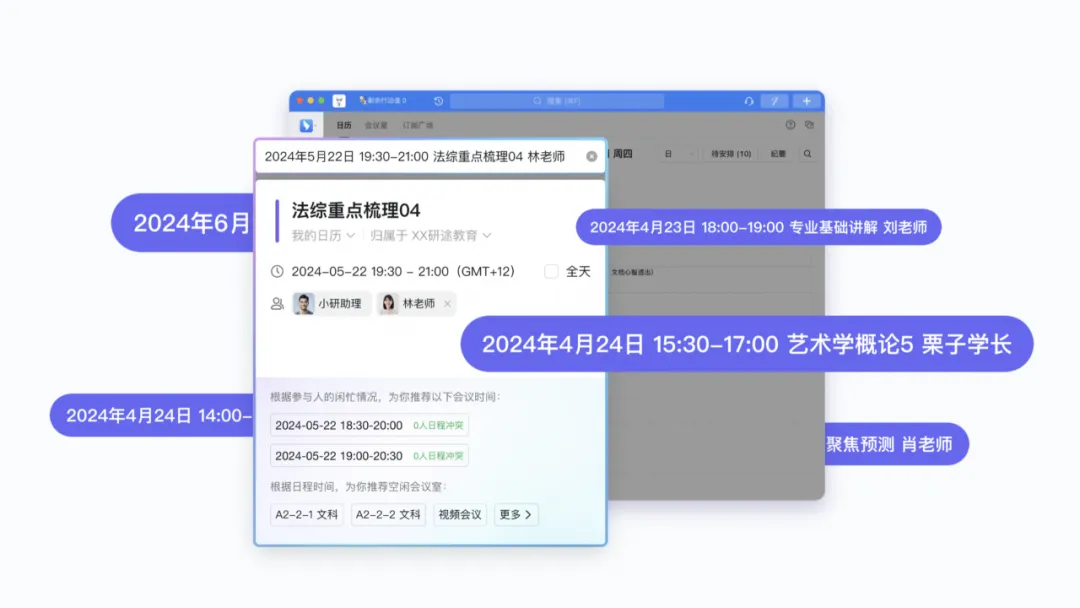
03. Document Preview Function Recommendations
$"Preview Scenario + AI, Making Information Processing More Accurate"$
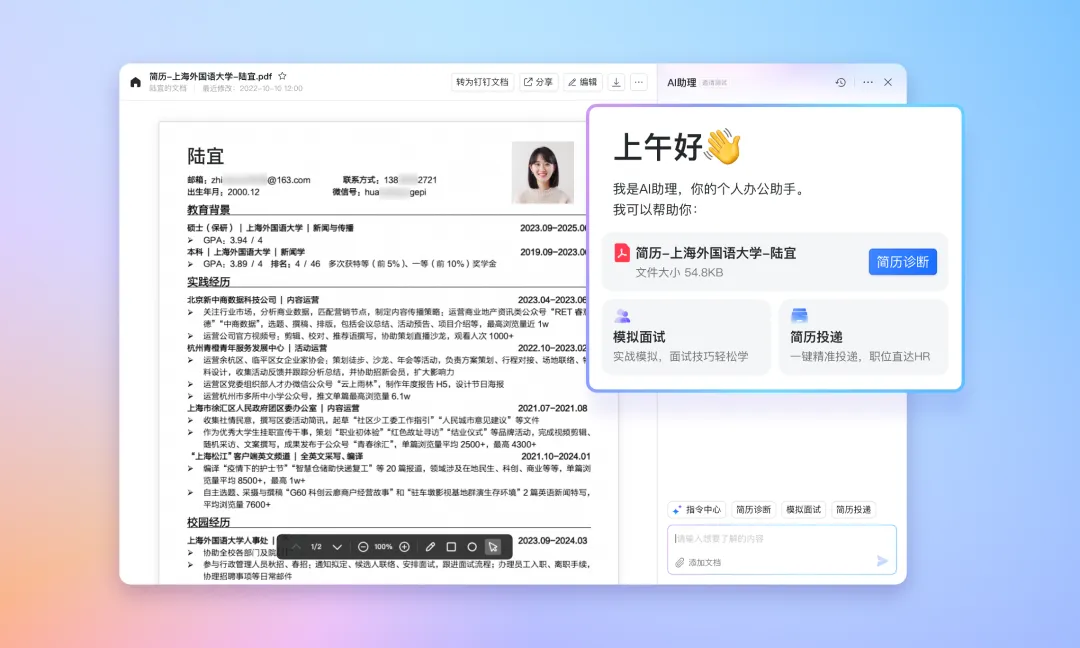
Identifying the Scenario
March and April are the prime time for college students looking for summer internships. One day, my cousin sent me her resume via DingTalk, asking me to review it and offer some suggestions for improvement.
Having worked with AI features for a year, I immediately thought if AI could enhance her resume. I asked for the resume diagnostics prompt from the Tongyi Qianwen team, used AI to generate a high-quality optimization suggestion for her, and recommended this approach. Unexpectedly, I received her three reactions in a row: I didn't know AI could be used for this, no clue how to use it, sounds complicated.
So, can I try teaching this method to users like her?
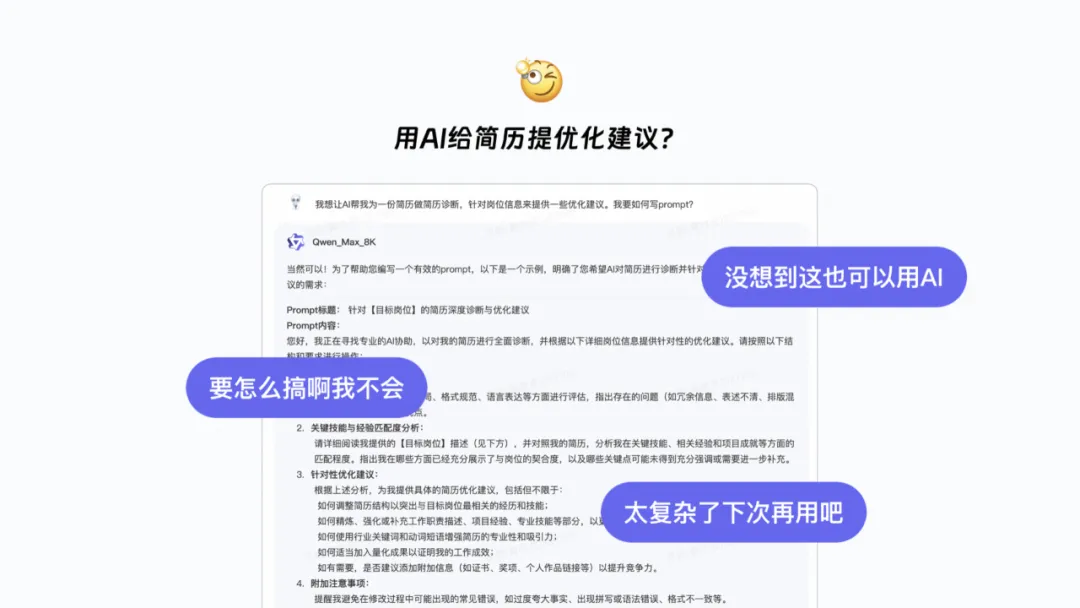
Scenario Analysis
Let's again break down the scenario, take for example the AI optimization of resumes for new college graduates. As the following graph illustrates, the steps involved in modifying resumes with AI are not complex, and after a few rounds of tuning, the quality of the modification suggestions generated is high.
However, my cousin's three questions made me realize the key problem is that users don’t think of using AI. In fact, the same goes for most people in the workplace. They don't use AI everyday like we do, and within their fixed workflows, they fail to realize how to apply AI to solve problems they encounter in their daily work.
Can we guide users through tasks by reinforcing goal realization and cultivate users' perception of AI's value?
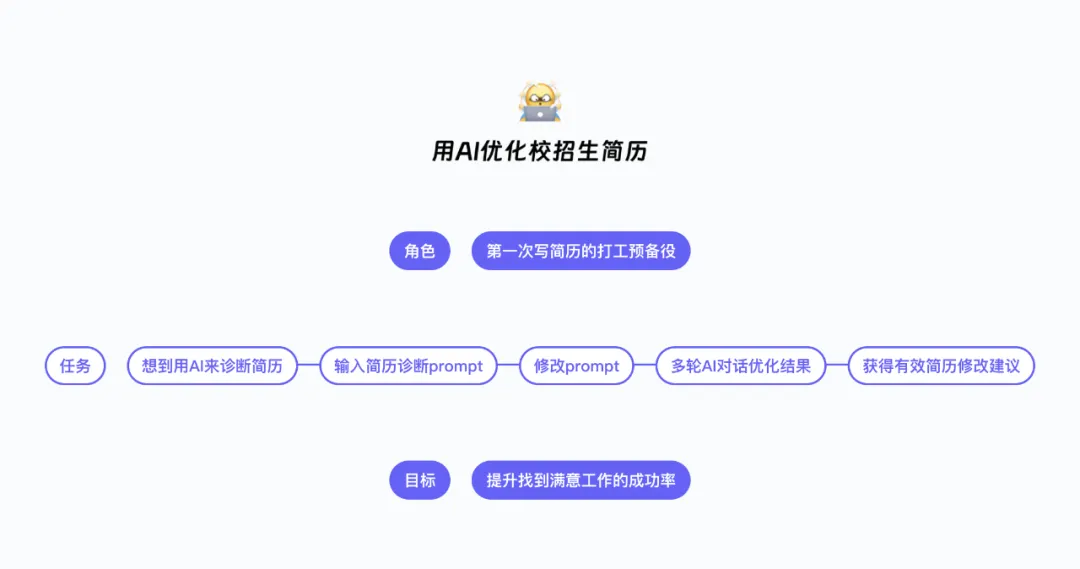
Scenario Analysis
When opening a resume file through DingTalk chat, the file preview interface serves as the optimal platform to highlight goals. After identifying a file as a resume through file type recognition, we can package relevant AI prompts as scenario-based features and present them to users, such as resume diagnostic and simulated interviews. Once users are attracted and click on the resume diagnostic button, AI quickly outputs modification suggestions, enabling AI to quickly resolve scenario-specific issues on behalf of the user, shifting from users seeking out AI to AI proactively reaching out to them.

The same approach can be extended to all files within DingTalk, where not only predefined AI capabilities can be recommended, but also advanced functionality already present in DingTalk can be suggested. Taking invoice files as an example, with similar logic, users can be guided to verify the authenticity of invoices or, for those on business trips, guided to submit approval requests for reimbursements with a single click.
Recommend corresponding scenario-specific features based on file types, user roles, and file access permissions, making file processing and refinement in DingTalk more precise and efficient.
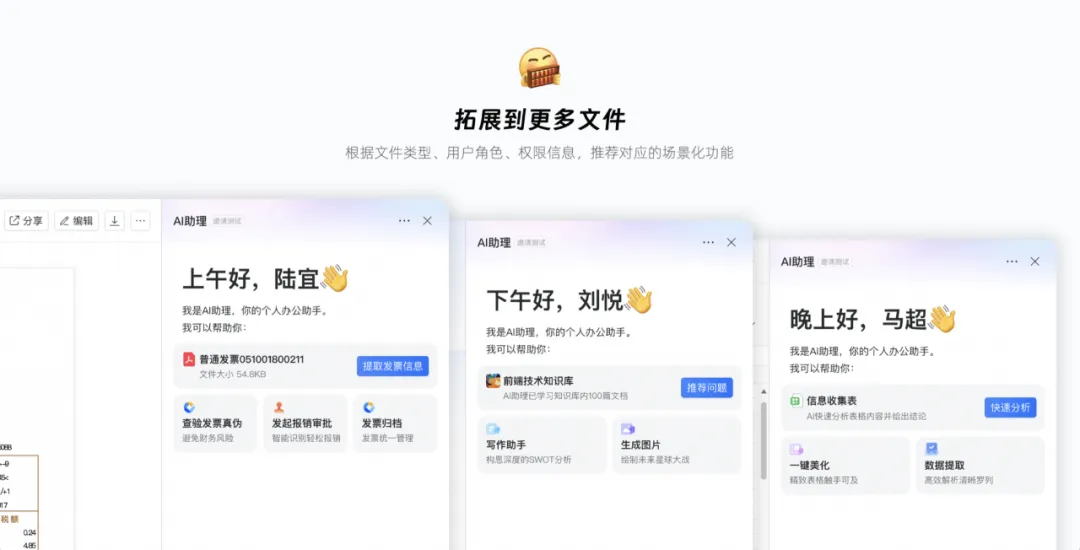
The above three cases demonstrate how we have used design innovation with AI to assist different workers in real-life work challenges, improving the efficiency or effectiveness of work information flowing within DingTalk.
Conclusion
$"Let technology serve humans, not humans serving technology"$
There is a saying internally at DingTalk: 'Every product within DingTalk is worth reworking with AI'. From the perspective of DingTalk designers, we believe that every product is worth rethinking from the angle of scenario plus AI.
The integration of scenarios and AI is mainly reflected in completing tasks with AI capabilities. Some tasks can be done more effectively with AI, while the speed of completing other tasks can be increased by replacing them with AI. AI's exceptional performance has made people's perspectives increasingly focus on: what processes can be simplified with AI, and what operations can be replaced? By diving deeper into AI's integration with specific functions in the task stage, we hope to provide users with various smart functions to complete their tasks. However, with this approach, it's easy to overlook the "role" and "goal" in the scenario.

It's AI that makes shared posters more attractive to join events; what makes meeting organizers satisfied is not the smart assembly but AI making it simple to organize meetings; what gives job seekers peace of mind is not the smart recommendation but AI enabling people with no experience to get high-quality advice at low costs.
We're not actually creating smart functions for users, but rather using appropriate AI capabilities to help them achieve their goals.
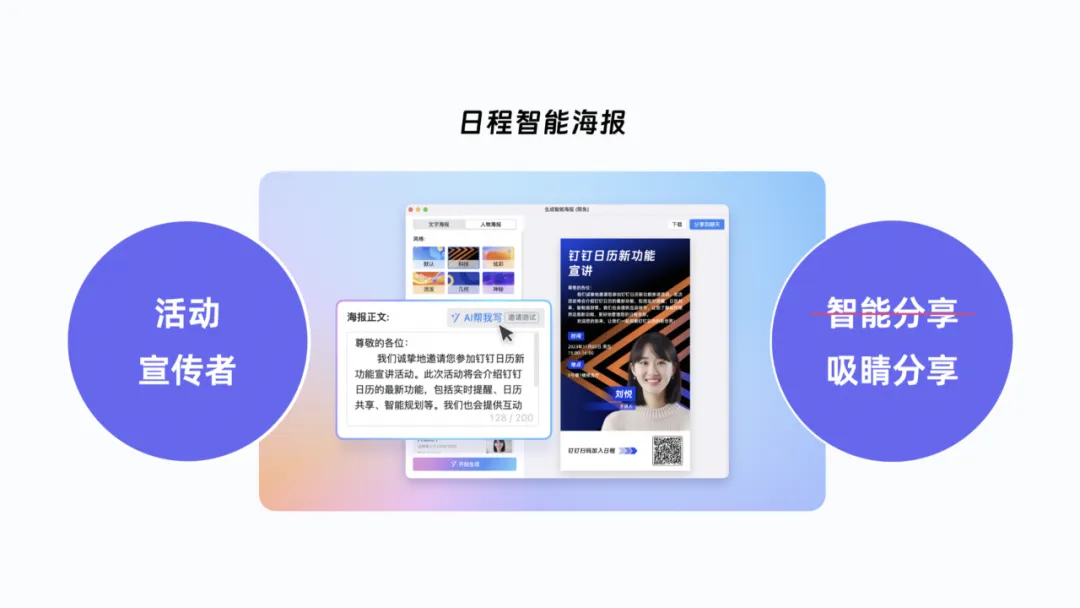
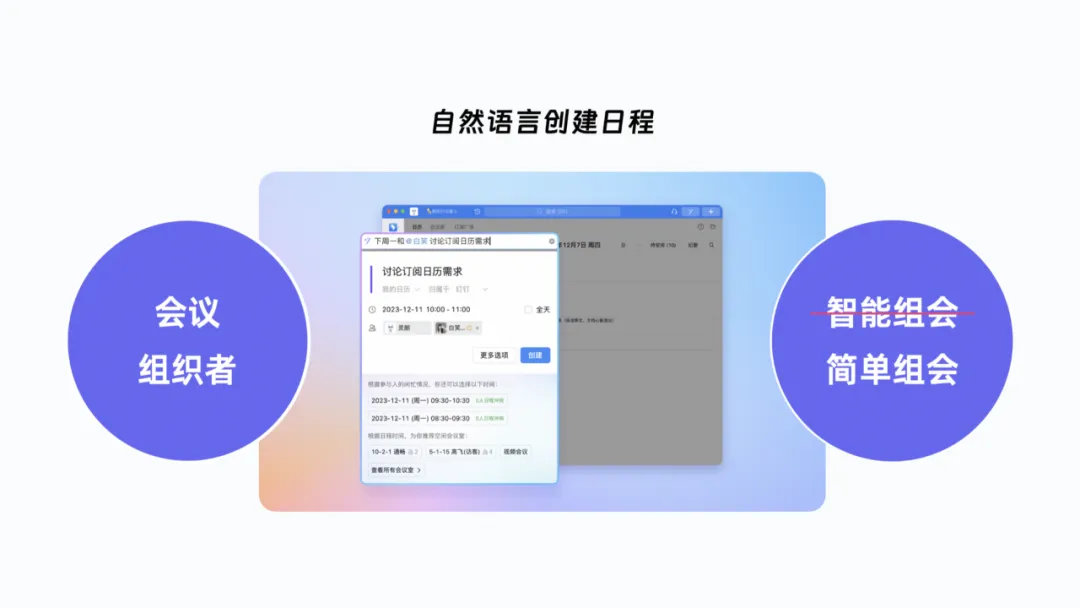
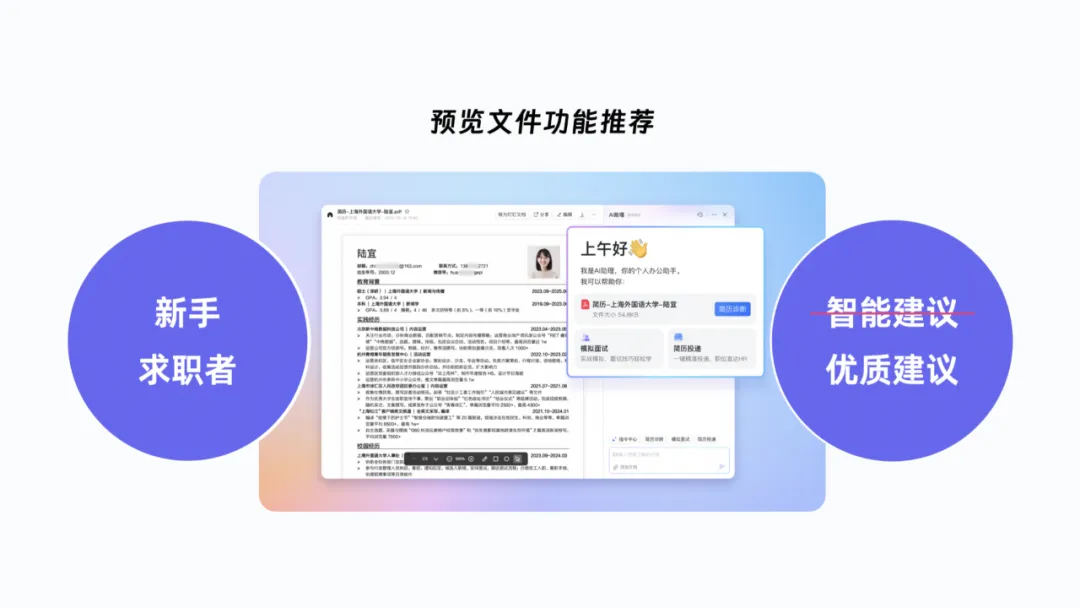
In the AI era, we need to get close to intelligence, learn to apply these advanced technologies to improve work efficiency, and optimize the quality of life. But in product design, we also need to learn to walk away from intelligence, avoiding making products into mere AI showcases that ignore users' true needs. Smart technology should be a tool for creating better experiences, not the end goal.
We envision AI as a new tool for enhancing DingTalk users' information collaboration efficiency. How we should explore intelligent design when applying AI capabilities to specific scenarios?
Understanding user characteristics and needs:
We should primarily consider the existing work habits of hundreds of millions of DingTalk users and their varying levels of trust and acceptance towards AI. We cannot expect them to change their habits to adapt to AI, as this would actually increase their work burden.
Combining design methods to identify efficiency entry points:
By collecting common tasks, challenges encountered, and areas for improvement through methods such as collaborative interviews and data analysis, and using empathy as designers to find entry points for efficiency improvement in various work scenarios, we can gain insights and make innovations.
Maintaining a curious and willingness to learn approach, effectively using new tools:
Understanding the strengths and weaknesses of AI thoroughly, selecting AI capabilities that best suit the given scenario, carefully considering how to integrate AI into the user's task flow through intuitive entrances, appropriate guidance, and natural interaction methods is crucial.
Finding the most natural paths for AI to integrate into the workflow of information, actively bringing AI closer to users so they can achieve their goals more effectively, efficiently, and elegantly.
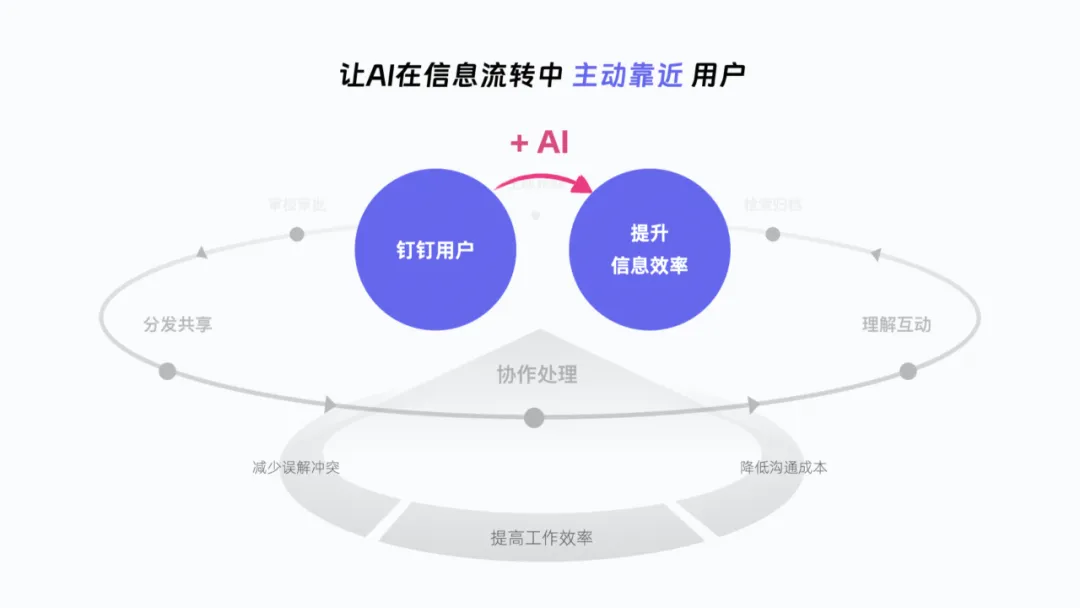
"Make technology serve humanity, not make humanity serve technology": We aim to make technology serve users' goals in achieving AI, serve designers' creativity and innovation through AI, and DingTalk designers are committed to making AI serve higher levels of enterprise information efficiency.
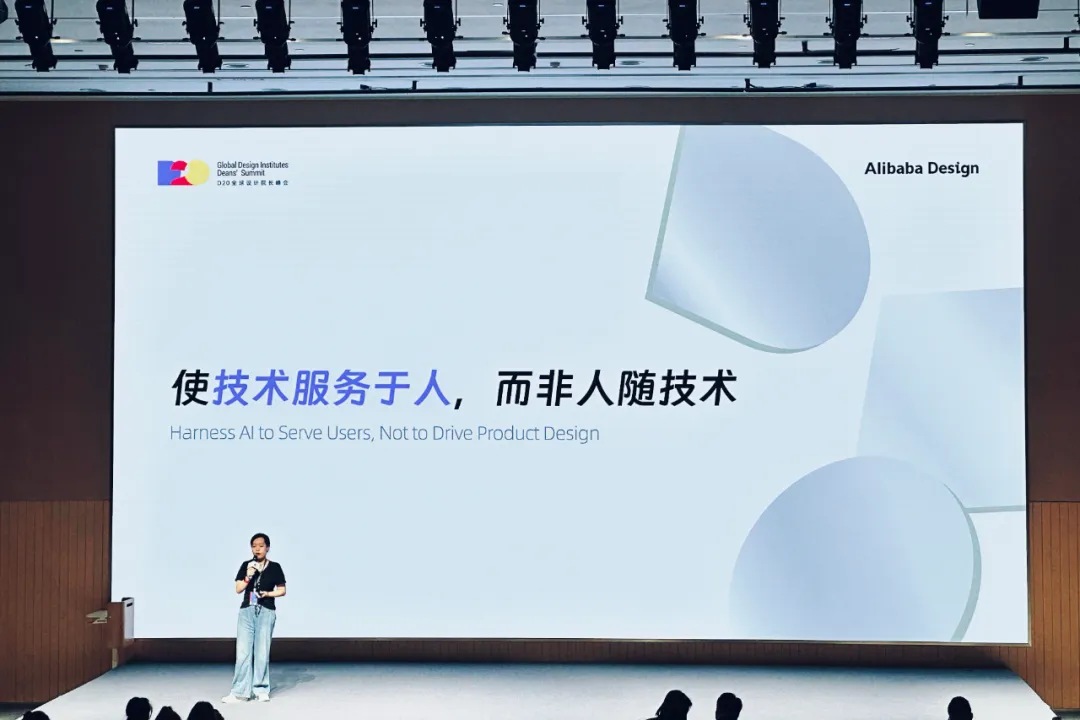
Precisely targeting the right customer groups to improve conversion rates is the most crucial part of any digital marketing strategy. However, in practice, how to efficiently gather potential customer information and engage with them effectively poses a challenge for many businesses. This is precisely where Beiyun Marketing (https://mk.beiniuai.com) can showcase its strengths.
Beiyun Marketing is an efficient, intelligent email marketing tool specially designed for modern enterprises. It can not only collect business opportunities and obtain potential customers' email addresses on related platforms using keywords provided by users and specified collection conditions such as location, language, industry, social media, and exhibitions but also generate email templates using AI intelligence, send emails to potential customers, track and record the email opening status, and automatically engage with customers through emails. If necessary, it can even send SMS messages.
Beiyun Marketing stands out with its delivery rate of over 90%, flexible billing model, and broad applicability. Whether you’re in e-commerce, cross-border trade, internet finance, education and training, or any other field, Beiyun Marketing offers tailored solutions to meet your diverse needs. Additionally, Beiyun Marketing utilizes global servers for message delivery, helping you send foreign trade development letters seamlessly to expand into global markets; at the same time, it supports domestic mass email sends, getting directly to your customers' inboxes with ease.
Through comprehensive data analysis and optimization features, Beiyun Marketing deeply analyzes user behavior and delivery data to continuously optimize your email marketing strategy, eliminating data blind spots. With countless email templates and a unique spam ratio scoring tool, Beiyun Marketing ensures your email marketing campaigns start from the leading position. Accurate data statistics allow you to immediately grasp the effectiveness of email bulk sending, with results clearly visible at a glance.
If you're looking to obtain valuable customer insights or seeking new ways to improve your marketing effectiveness, Beiyun Marketing will be a trustworthy choice. Visit Beiyun Marketing's official website right now to experience efficient smart email marketing!
DomTech is the official designated service provider of DingTalk in Hong Kong, dedicated to providing a wide array of DingTalk services to clients. If you'd like to learn more about applications on the DingTalk platform, feel free to reach out to our online customer service. With an excellent development and operation team and rich market service experience, we can offer you professional DingTalk solutions and services!

 English
English
 اللغة العربية
اللغة العربية  Bahasa Indonesia
Bahasa Indonesia  日本語
日本語  Bahasa Melayu
Bahasa Melayu  ภาษาไทย
ภาษาไทย  Tiếng Việt
Tiếng Việt  简体中文
简体中文